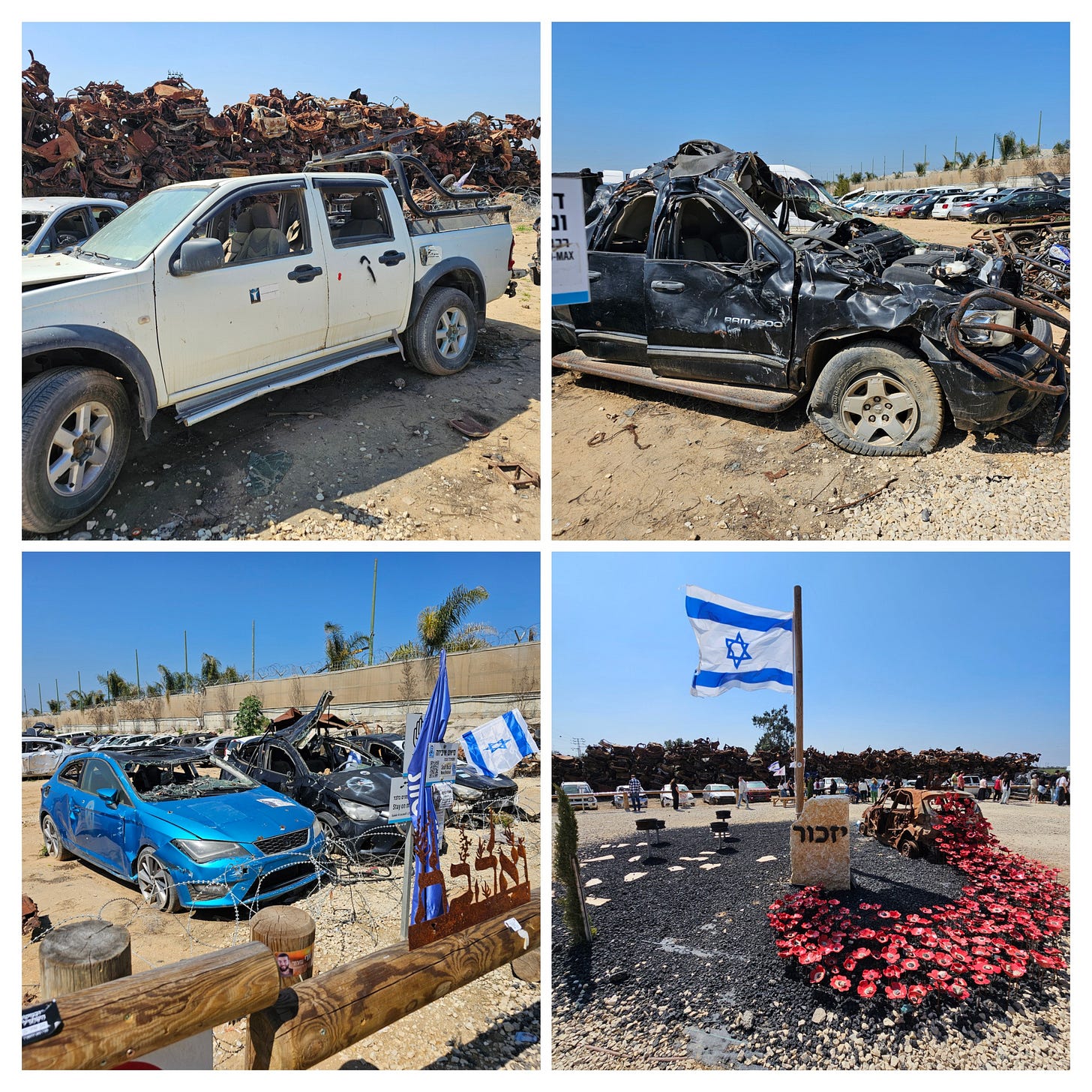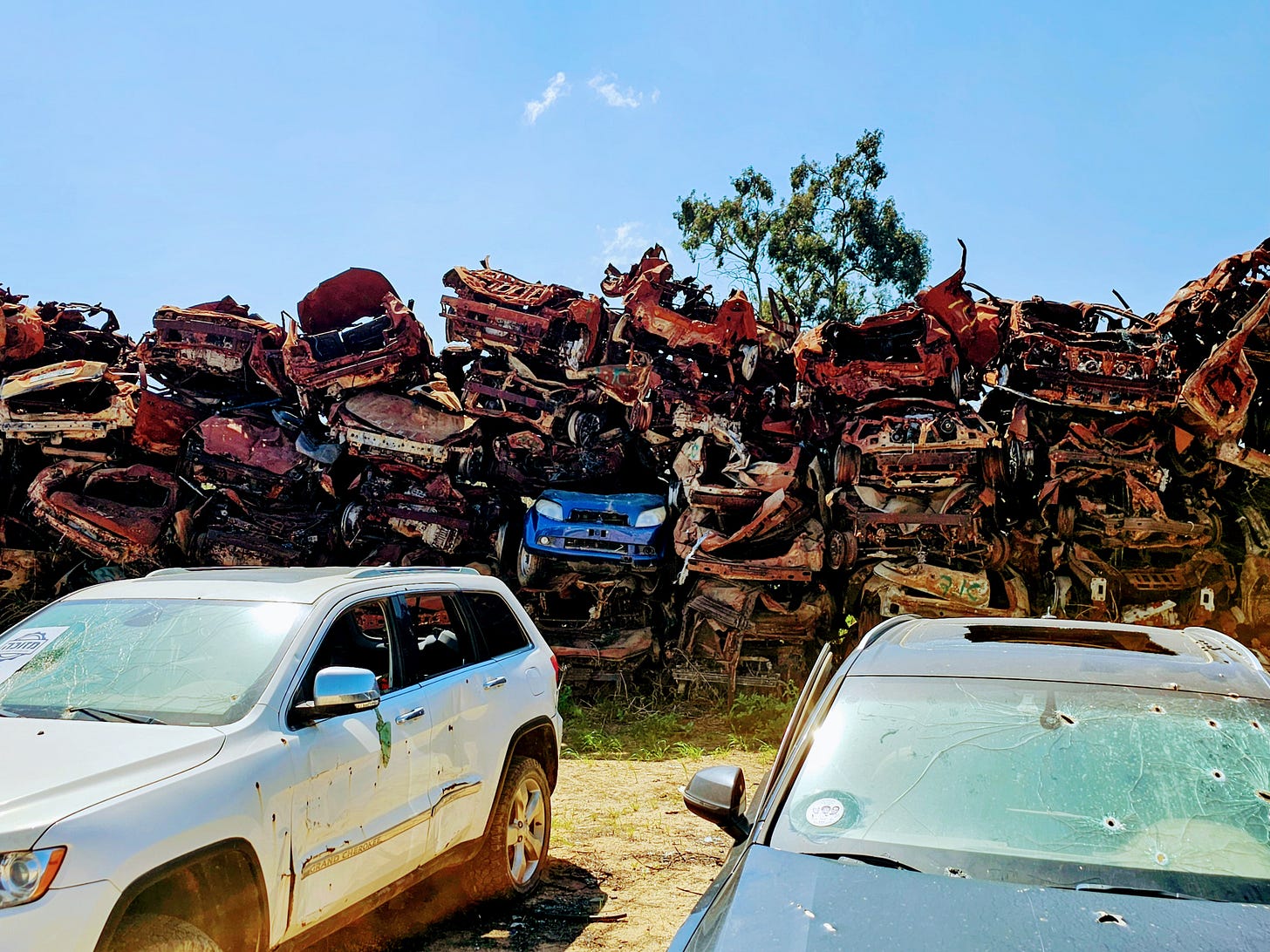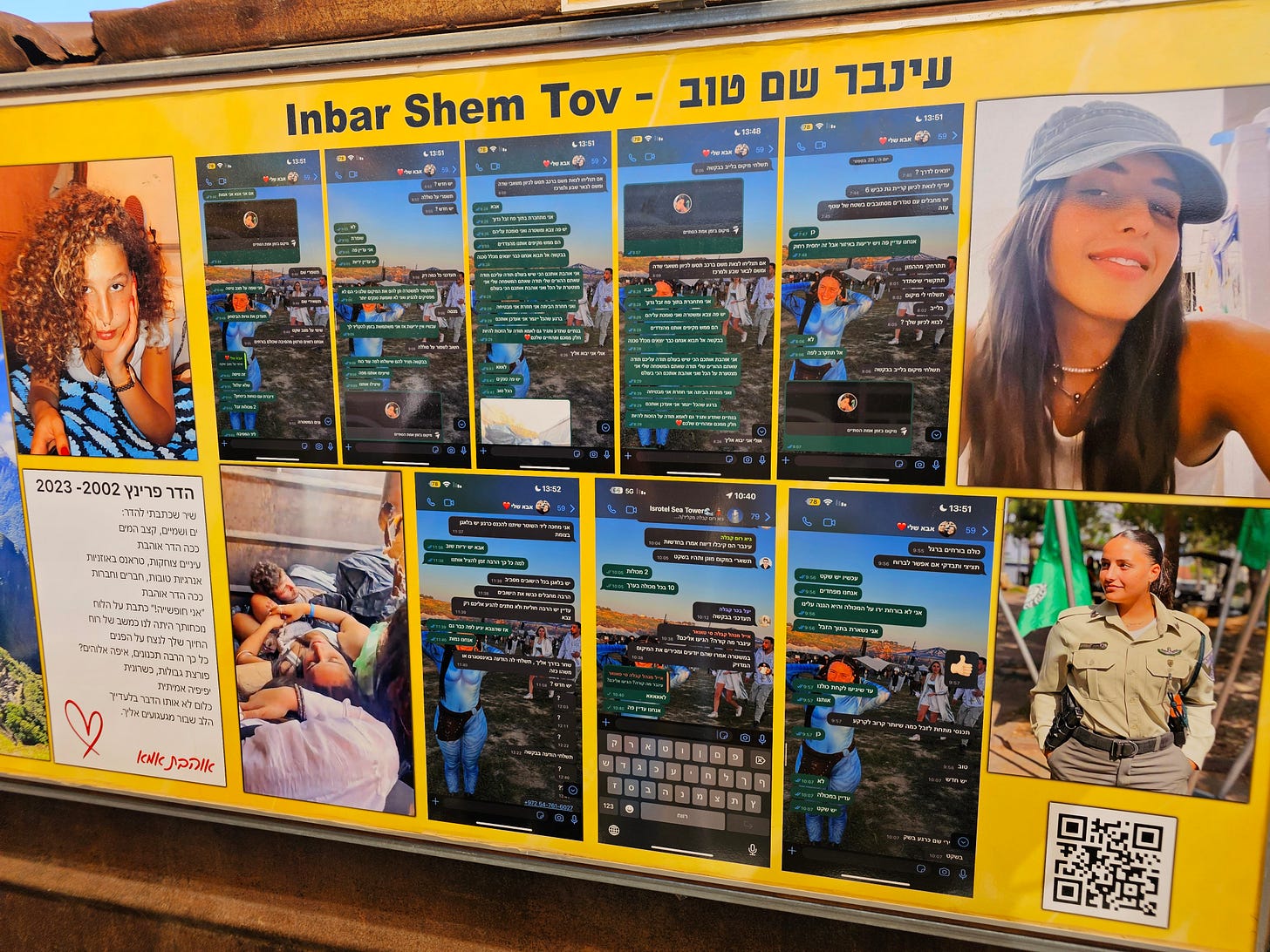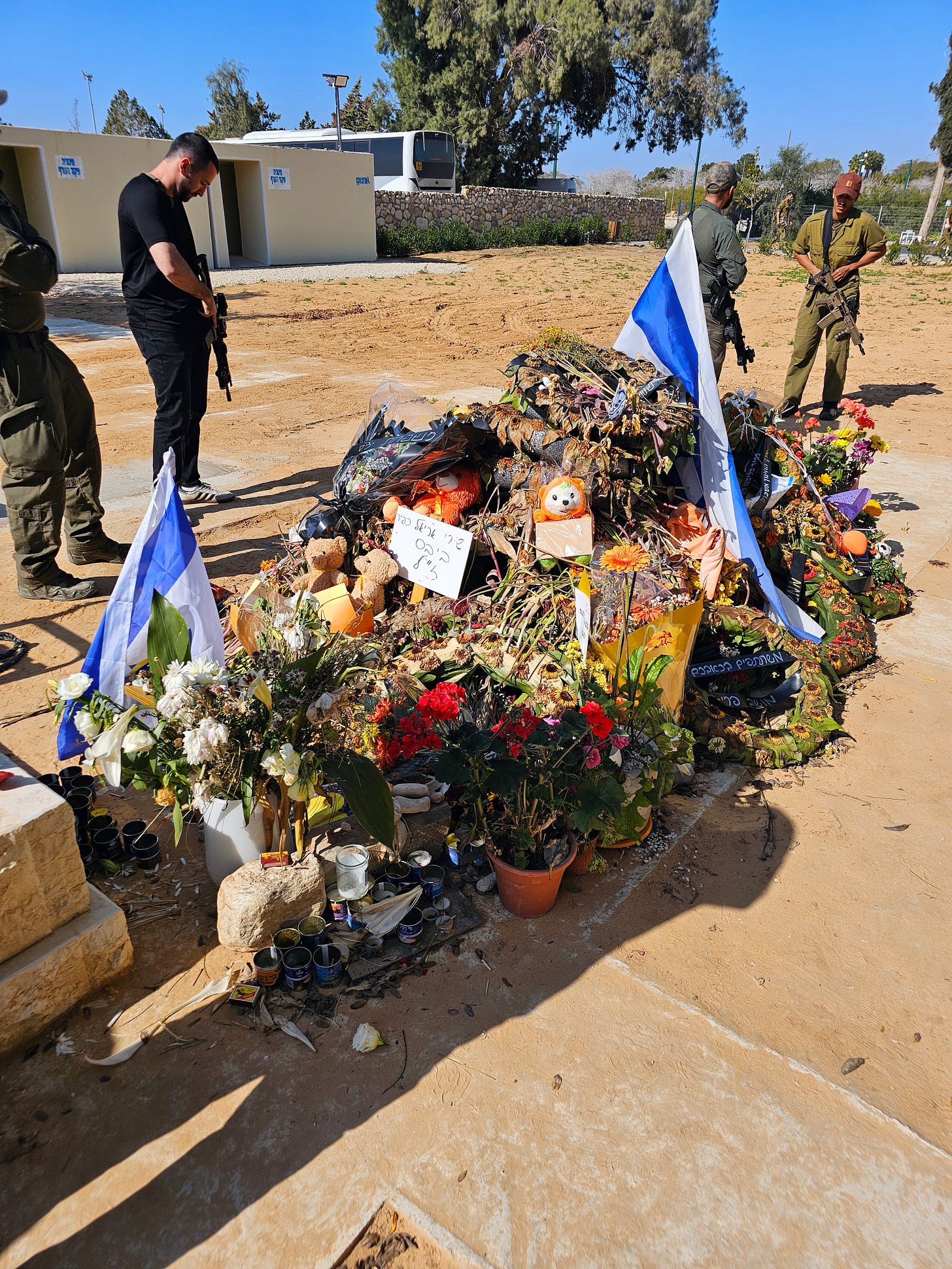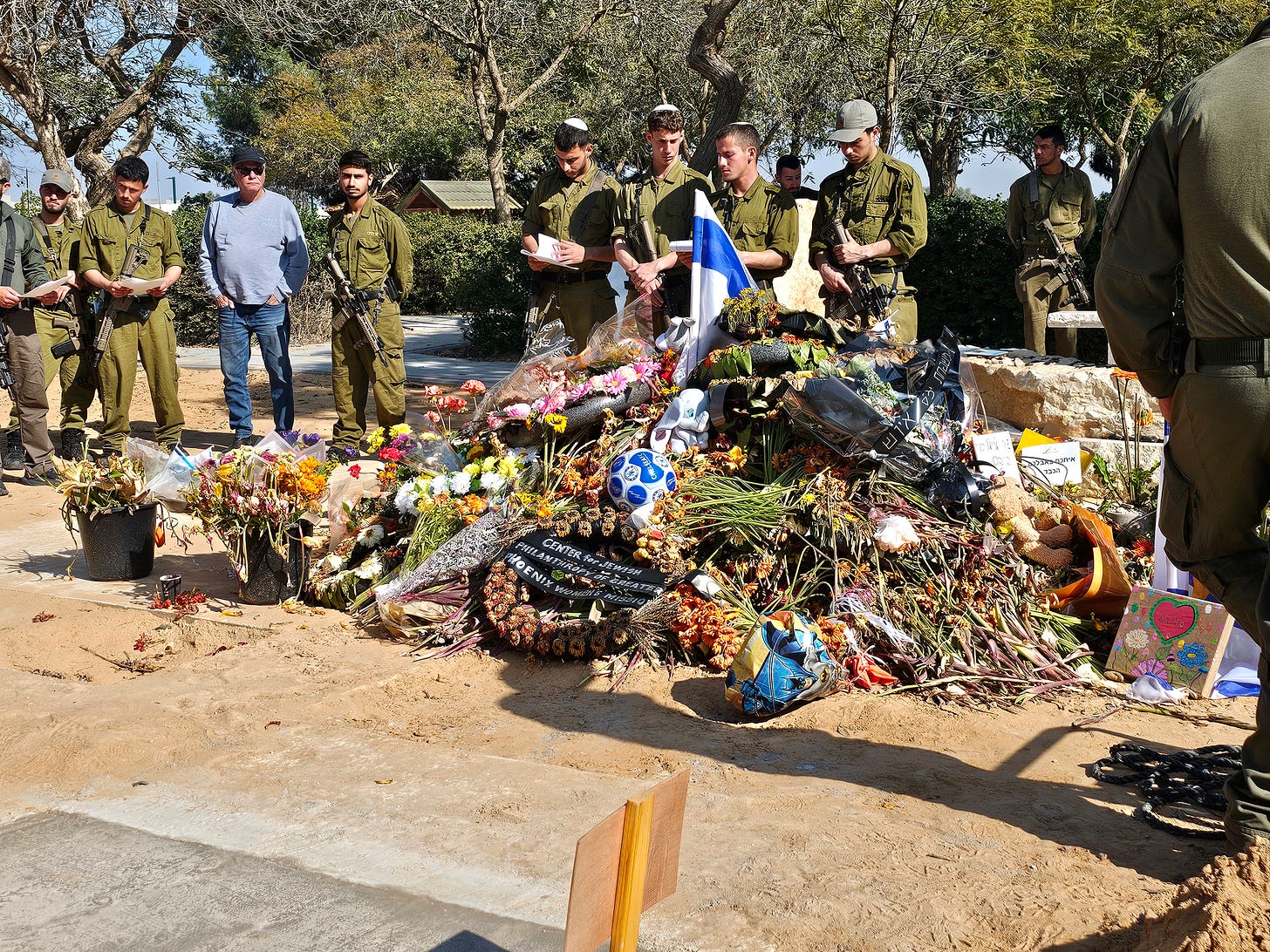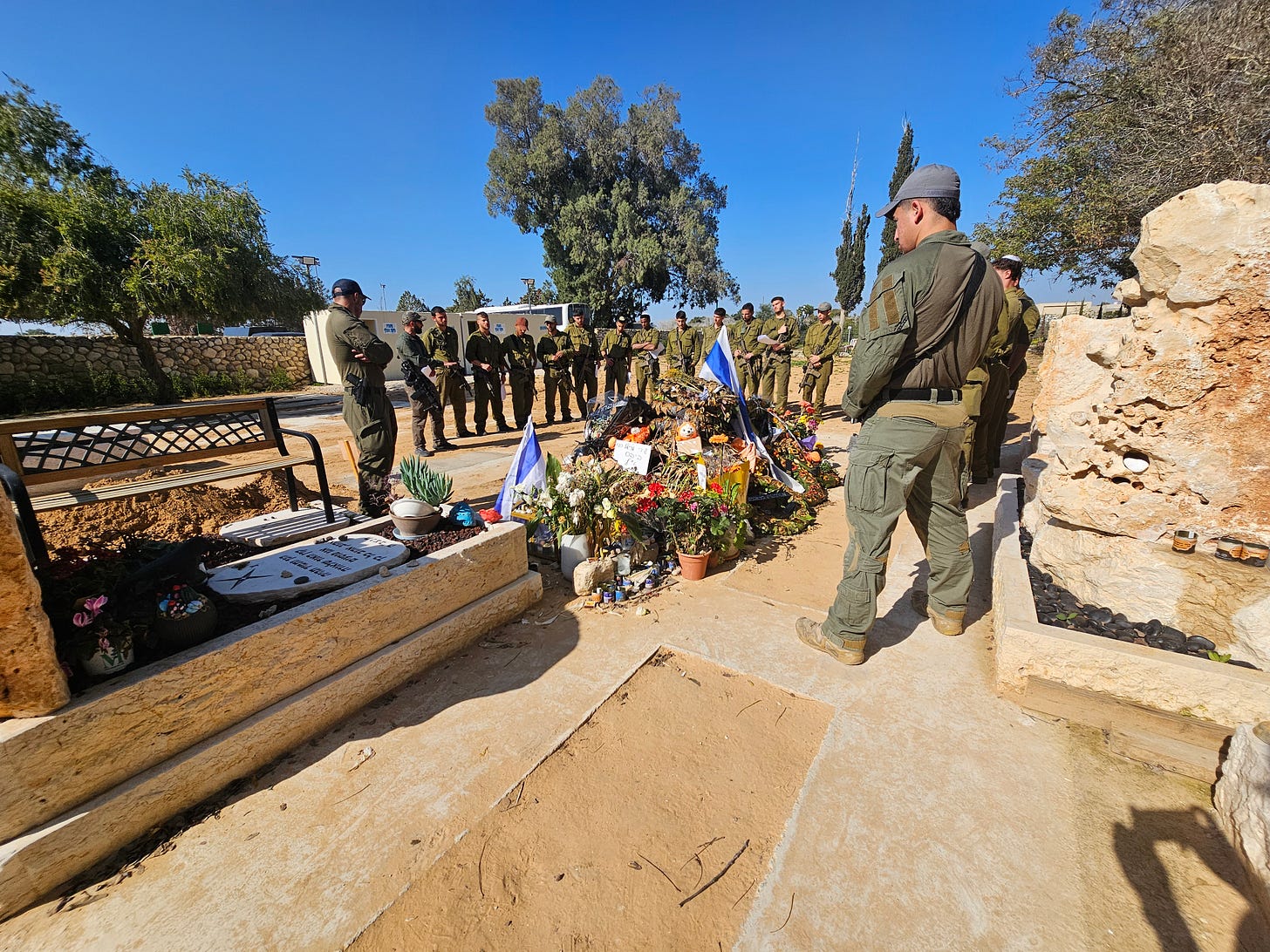Yellow, blue, red, and orange. These were the colours of my second day in Israel.
Yellow
In and around the Gaza Envelope, the colour you see more than any other is yellow. Flags and ribbons line the streets, while bumper stickers and yellow banners line everything else. Yellow memorials sit along Route 232, empty plastic chairs with the faces of hostages sit outside gas stations, and bicycles and scooters, painted yellow, dot the countryside.
I began my day meeting an incredible group of educators who are in Israel with UJA of Greater Toronto, for a guided tour of Kibbutz Kfar Aza. One of the kibbutzim hardest hit on 10/7, the kibbutz buried 64 members of the community in the days following the massacre, along with another 34 soldiers who died on those hallowed grounds. Kfar Aza only housed about 950 individuals, of whom 19 were kidnapped to Gaza. Today, 14 have returned home, to run tours and maintain the land, while the others remain dispersed around Israel.
Our tour guide was Shachar Shnurman, who became infamous for being the first Israeli to return to Kfar Aza in December 2023, just a few weeks after the war began. With typical Israeli charm and some humour, Shachar showed us around the place he called home for many decades, now deserted. He has started to host Monday evening barbeques for the soldiers in the area, hosting up to 200 at a time.
Everywhere in the kibbutz were yellow signs - calling to bring back the hostages safely, including Gali and Ziv Berman, twin brothers, who were recently confirmed to be alive in Gaza.
Walking around the kibbutz, the words vulnerability and failure came to mind. The kibbutz was so vulnerable to an attack from outside, clearly lacking so much of the protection needed to fend off marauding Palestinians from Gaza. Inside the kibbutz, front doors opened up to wide spaces and gardens, that one day in October were fired upon by terrorists intent on killing and maiming. The failure is clear. A broad space - a buffer zone - between Gaza and Kfar Aza spread out for a kilometer alongside the border of the kibbutz, and the Israelis failed to stop thousands of terrorists coming across this open land, on foot, motorcycle, by truck, to attack us. They were vulnerable, and Israel failed them.
We walked past the homes of Keith and Aviva Siegel and their orange trees, Doron Steinbrecher (with a poster with her picture and name in bright yellow letters), and learned what the graffiti’d codes on the outside of the houses meant: the number of the army units that cleared the space, what Zaka found while cleaning inside - human remains, blood - and how many bodies, Israelis or terrorists, or both, were found within.
We walked - with tear-soaked cheeks - along the avenue of student housing; small houses where students who attended Sapir College lived. Their houses were covered with remnants of fire, bullet holes, collapsed roofs. On the floor lay shampoo bottles, food containers, papers, garbage, a set of keys on the wall with a Minion keychain, glasses, and shoes still on the shelves. A testament to normal lives, utterly destroyed.
This was holy ground - where our brothers and sisters fought and died as martyrs. For being Jewish. Like so many of their brothers and sisters before them. We went into the home of Naor Hasidim and Sivan Elkabets - a beautiful young couple who lived together, and who died together, hiding under the bed in their rocket shelter. Their home - turned into a museum by Sivan’s courageous and stoic parents - is a shocking - utterly utterly shocking - exhibition of what happened that day. Blood on the sofa, bullet holes everywhere, and heartwrenching screenshots of Sivan’s last Whatsapp conversation with her father, checking whether he was OK.
He was.
She wasn’t.
We left Kfar Aza wondering what would become of this living memorial. Could this place, with such horrific memories, filled with beautiful yellow flowers, stunning under a yellow sun, remain in this condition? Or, to effectively move on, would the remains need to be buried, like their prior inhabitants, to make room for a future generation?
Blue
I left the UJA group and rejoined my cousin Nadav to travel to what has become known as the car cemetary or car wall. It is a place where the burnt our remains of hundreds of Israeli cars have been gathered, destroyed on 10/7 along Route 232 or near the site of the Nova Festival.
Driving along Route 232, you suddenly see what immediately looks like a massive parking lot. I knew what we were going to see, but I still saw the cars from a distance and wondered “Hmm, I wonder what all those people are there to see.” We turned left, and I immediately realized that it was actually those cars that I was there to see.
The memorial is made up of three sections: a car wall made up of the charred and rusted out bodies of hundreds of cars that were burned on 10/7; hundreds of other cars parked behind them in rows (what I thought on the drive in was a parking lot); and then several other cars - including a few Hamas vehicles - displayed along with pictures of the owners, and the stories of what happened to them. QR codes are available to scan, to read more about the stories of each vehicle.
The cars are badly damaged, with bullet holes shattering windows, and some with the rooves blown entirely up and off. The Hamas truck still has the machine-gun stand mounted on the back, with Arabic writing on the gas tank, and a bumper sticker on the side that says in English, “You Live Everyday, You Only Die Once.” Admittedly (I can’t find the answer to this), I don’t know if this sticker belonged to the Hamas members who drove the truck, or if it was put on afterwards. But if its the former, this was a chilling reminder of the nature of the enemy.
Each of these cars tells a story, but like so much of 10/7, the scope is too much to grasp. And in the burnt out cars, the tragedy is multiplied. Zaka had a particularly difficult time cleaning out the burned cars because in many cases, it was difficult to locate the DNA from the charred human remains. The bodies were fused together with car parts, and it was impossible to ensure that the blood and body parts were adequately removed. This is why, in some cases, cars were buried, because of the people (DNA) that may still be inside.
I chose blue however because in the hundreds of brown and rusted cars that make up the “wall” there is a single blue car. I am not sure (and would be glad to learn) why a single blue car was placed among the charred remains of the others, but Nadav observed that this was like the girl in the red coat in Schindler’s List, who stood out in the context of the black and white movie. If this was indeed the case, a stark single blue car standing out among the wreckage, perhaps it was meant to show just that: that there is a story to each car, that each had an owner, a person, who drove others to the south, and that each succumbed to the bullets, rockets, or fire of the Palestinian perpetrators.
That from within each car, there is a story.
Holy ground occupied by both man and machine.
Red
We next stopped at the site of the Nova Festival, for which I was truly unprepared. The signage at the entrance - sitting amidst a sea of red poppies growing in the green grass - tells you where you are, but it is impossible, until you are there, to realize the utter scope of the massacre perpetrated. On the morning of October 7, 2023, 364 innocent children of God were brutally murdered by Palestinian hatred. Each of their faces greets you from the ground where they came to dance. The ground beneath their pictures, and beneath our feet, soaked through with their red blood, forever embedding their legacy and names with this dusty field.
The Nova site is a touching memorial. Everywhere are faces of the beautiful Israelis - and others from all over the world - who came to party. Who loved life, and who died wrapped in the arms of people they loved. Their pictures are everywhere, and the organizers have done a marvelous job of telling the story of what transpired, and who attended. Hundreds of tourists milled around, wiping tears from their eyes, taking pictures, and most importantly, reading the stories posted about the countless Nova victims. Only in this way can their memories live on.
The heartbreak of the spot - though self-evident - is further apparent when you realize that the family of each victim has meticulously crafted the memorial for their own child/parent/sibling/cousin/friend, with visitor books placed on the ground, favourite records/music albums, pictures, jewellery, lining the ground.
Around the site are thousands of bright-red ceramic poppies. They are laid out in the shape of a path, with a giant red Magen David made out of the red flowers. Whatever the meaning, the flowers surely symbolize not only the blood-soaked earth on which they are planted, but also the resilience of the nation of Israel. They are a stark - truly stark - reminder of what happened. The colour and the feeling of being there will not soon leave my mind.
Orange
Leaving the Nova site, Nadav and I then drove a short distance to Tzohar, where Margit and Yossi Silberman are buried. The Silbermans were murdered on 10/7 in Kibbutz Nir Oz. They were just 63 and 67 years old. They were buried there shortly after 10/7, but their daughter and grandsons were buried in the plot next to them, in a single coffin, just two weeks ago: Shiri, Ariel, and Kfir Bibas.
Unlike the tourist sites I had visited earlier in the day, the Tzohar Cemetary was quiet. Nadav and I parked and approached the grave with reverance. they were just buried here 13 days ago - the flowers wilting though holding their colours on the freshly dug grave, with wreaths and balloons, some orange, some with batman, still filled with helium, lying alongside them.
I approached gently, honestly feeling like I was trespassing on sacred ground. Only two weeks prior, the eyes of Israel were on this site, as Yarden Bibas, a few years younger than me, said goodbye to his “Amor” Shiri, and his two young sons, virtually the same age as my children. I didn’t want to stay long - it was emotional and I did not want this to become a tourist attraction - it was too fresh, too new. But then a bus pulled into the lot, and I watched as a unit of soldiers, in their crisp green uniforms, approached the gravesite and formed a semi-circle, with their commanding officer in the centre.
The officer told his men that they had come to this site to pay respects, and to remember their mission: to protect the people of Israel. He implored them to be brave, to remember what their mission was, and he recalled that at the end of the day, we are all each only accountable to Ha’kadosh Baruch Hu: God, on high, who will judge our actions. He held in his hand a paper from which each of his men took turns reading a prayer, or a Psalm. He ended with a reminder that man is made from dust, and returns to dust, and that it is important to remember that what comes in between is a mission to our brothers, and to the Jewish people.
One of the soldiers said the mourner’s kaddish, and I wept as I prayed alongside them. Here, on the brown-orange dirt, with a deflated batman balloon near my foot, and wilted orange lillies holding their colour, and their courage, for all those who came to pray.
I felt blessed, humbled, privileged, and saddened, to end my day in this way. A day filled with things that I never wanted to see, but that I will now never forget. That we each have a duty to hopefully see in our lifetimes, akin to the mass graves in Poland, or the gas chambers of Auschwitz. We can never forget.
Sacred ground
When I was in Poland for the first time, I was struck that the entire country felt like a mass Jewish grave. Here is a concentration camp, here is a death camp, here a mass grave, here a shooting pit, here a gas chamber, here a ghetto, a memorial, a torched synagogue. But in Poland, the Holocaust ended Jewish life in Eastern Europe.
Israel took up the torch, where it still burns bright.
So what does the South of Israel do, when so much of it also feels like a mass grave? When the land becomes holy because of the Jewish blood spilled? When the memorials are built even before we know how many are dead or alive? When people are still kidnapped, bodies are still missing, and we cannot even put a final tally on the numbers yet? How do we treat this living memorial in the south, where people drive to work on roads lined with yellow ribbons, blue cars, seeing the blood-red poppies dotting the surrounding hills, and where the sun sets orange to the West, over the homes in Gaza of those who perpetrated this evil?
It is too early to tell, and in my opinion, too early to plan. Despite the current ceasefire, a war still rages on. Within the government, within our people, within our country, and within each of us. There is much to resolve and understand, but only by visiting these sites, and seeing them with our own eyes, can we play our own small part: bear witness. Realize what happened. And tell the stories to others so that we, and they, will never forget.







